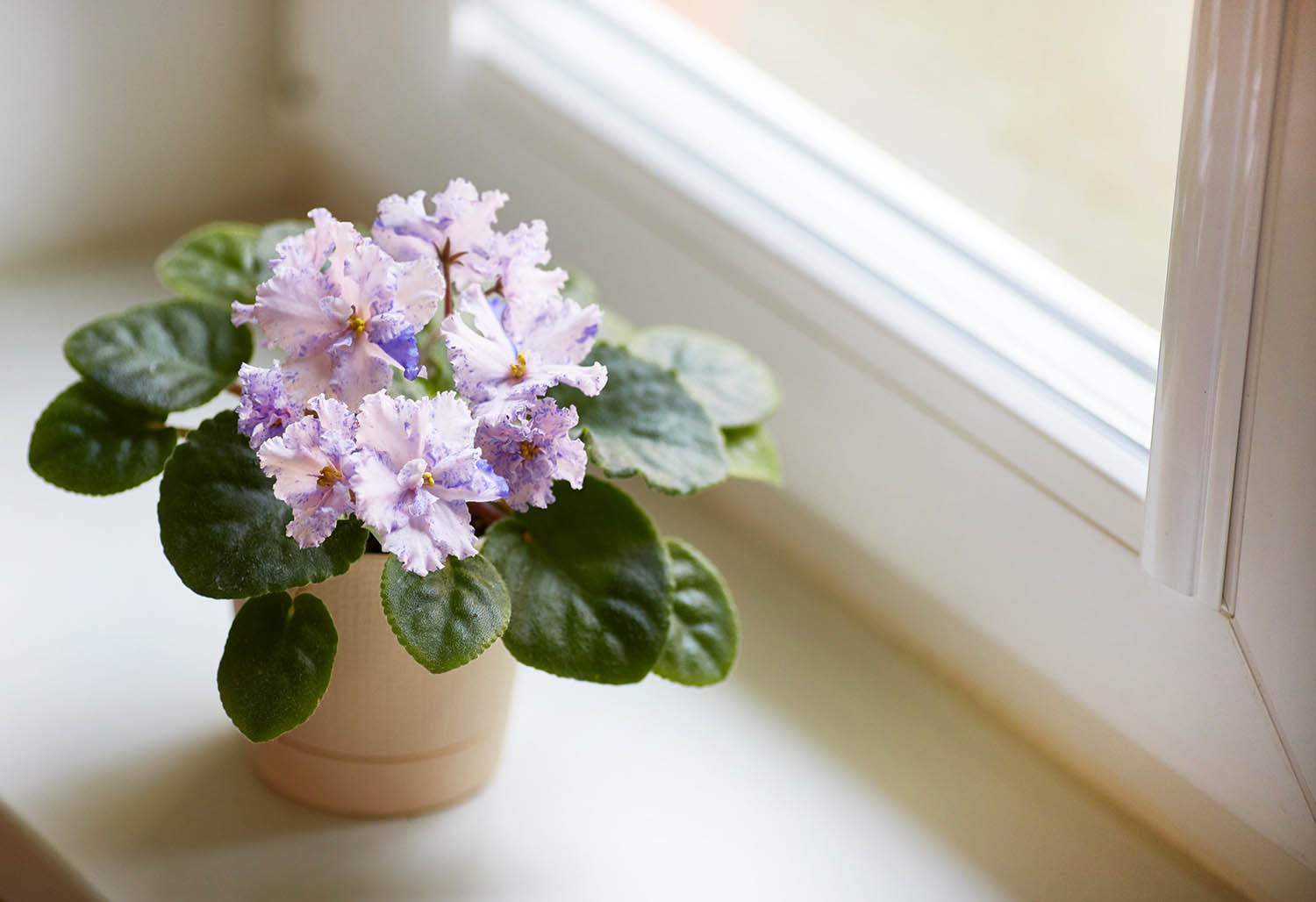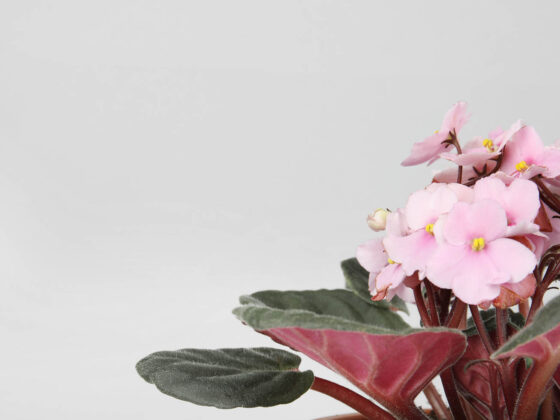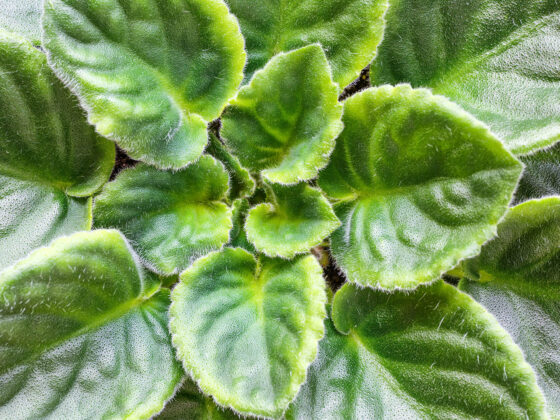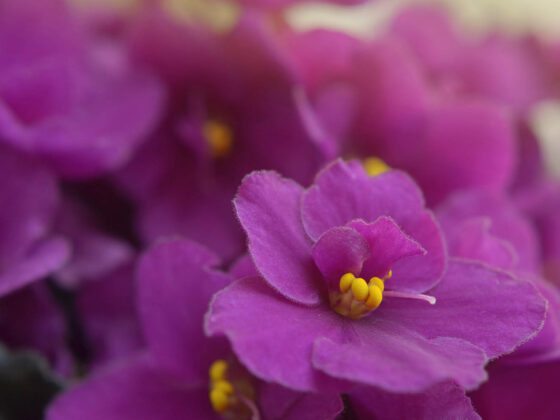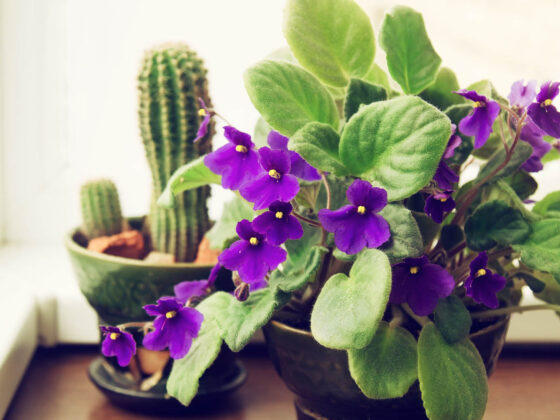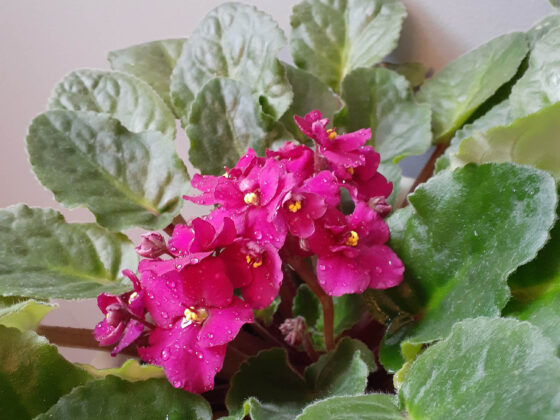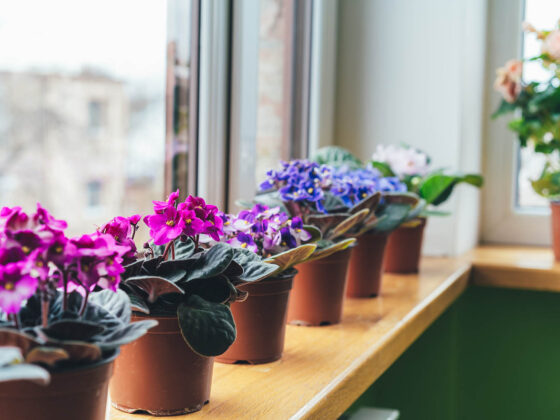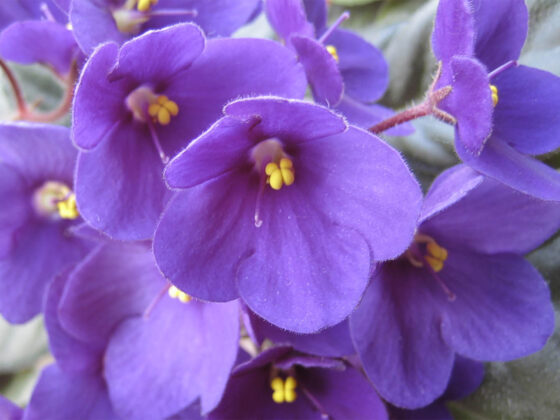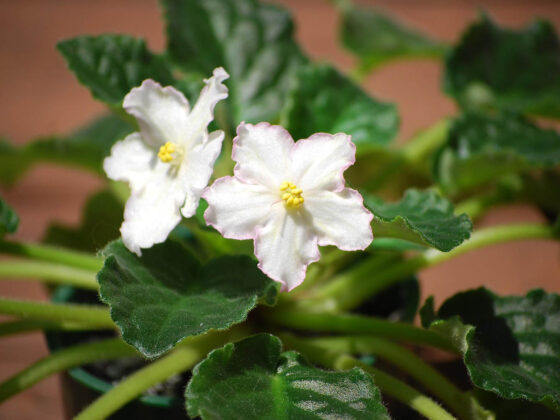It can be tricky to tell whether your African Violet is getting too much or too little light. The effects of lighting problems don’t always show up right away, and sometimes they can resemble other issues. But good lighting is a key part of raising a strong and beautiful Saintpaulia. So what kind of light does an African Violet need and how much do they require?
African Violets do well in bright light, but not in direct sunlight. In full sun, their leaves get burned. However, too much shade makes them grow skinny, pale, and weak. East-facing windows usually offer the right amount of light for African Violets, as do spots a few feet back from southern exposures.
Any increases to your African Violet light exposure should be gradual. Sudden shifts can put a strain on your plant. This article will review some of the indicators that your African Violet is over- or under-lit, and help you find a solution. Get ready to light up your Saintpaulia’s life!
Are African Violets Low-Light Plants?
Did you know that Saintpaulias originated in the cloud forests of tropical Africa? If so, you might assume that your dim office or the shadowy corner of your bedroom has the right amount of light for African Violets. But although these plants need shade, they also love bright light.
Confused? Think about it this way: even the floor of a cloud forest gets more sun throughout the day than most homes. But that light takes a roundabout route to reach low-growing plants like Saintpaulias. It bounces off rocks and filters through the foliage of taller species along the way.
That’s what we call indirect light. When the sun shines right onto the leaves of a plant, that’s direct light, which is harsher and hotter. Direct sun can damage the foliage of plants that evolved in environments full of dappled light – like African Violets.
How Much Light Do African Violets Need?
Okay, so we know African Violets prefer indirect light. How much of it do they need to bloom and grow?
The right amount of light for African Violets is at least 8 hours of indirect light per day. If it gets less, your Saintpaulia will rarely flower and its growth will be limited. The light can be quite bright as long as it’s indirect. To be precise, the optimal intensity is 900-1100 foot-candles, or 10-20,000 lux. If you want to get really scientific with your African Violet collection, you can purchase an illuminance meter to test the brightness.
For the absolute best blooms and most luscious growth, try to give your African Violet 12-16 hours of daylight. This will probably require grow lights, especially if you want to do it year-round. This bulb is our favorite and the one we always recommend to our readers.
Be aware that you can run into diminishing returns – African Violets won’t flower if they’re lit up around the clock. They need at least 8 hours of darkness per day to bloom. Turning the light off and on with an outlet timer helps to mimic the daytime/nighttime routine they would experience in their natural habitat.
Is Your African Violet Getting Too Little Light?
Maybe you’re not totally sure whether your African Violet is in a bright enough space. How can you tell if it’s under-lit?
As we hinted above, the first sign is often a failure to bloom. Flowering is one of the biggest drains on a plant’s energy budget. When your African Violet isn’t getting enough juice from the sun, it can’t blossom.
Slow growth is another indicator. Saintpaulias usually grow quickly enough that you need to repot them frequently to hide their long, woody-looking trunks. An African Violet that hasn’t gained any height in 6-12 months is probably not getting enough sun.
However, the individual leaves often grow longer in low light than they would if your plant was well-fed. This process is called etiolation. Your African Violet is spreading out farther to see if it can reach a brighter spot.
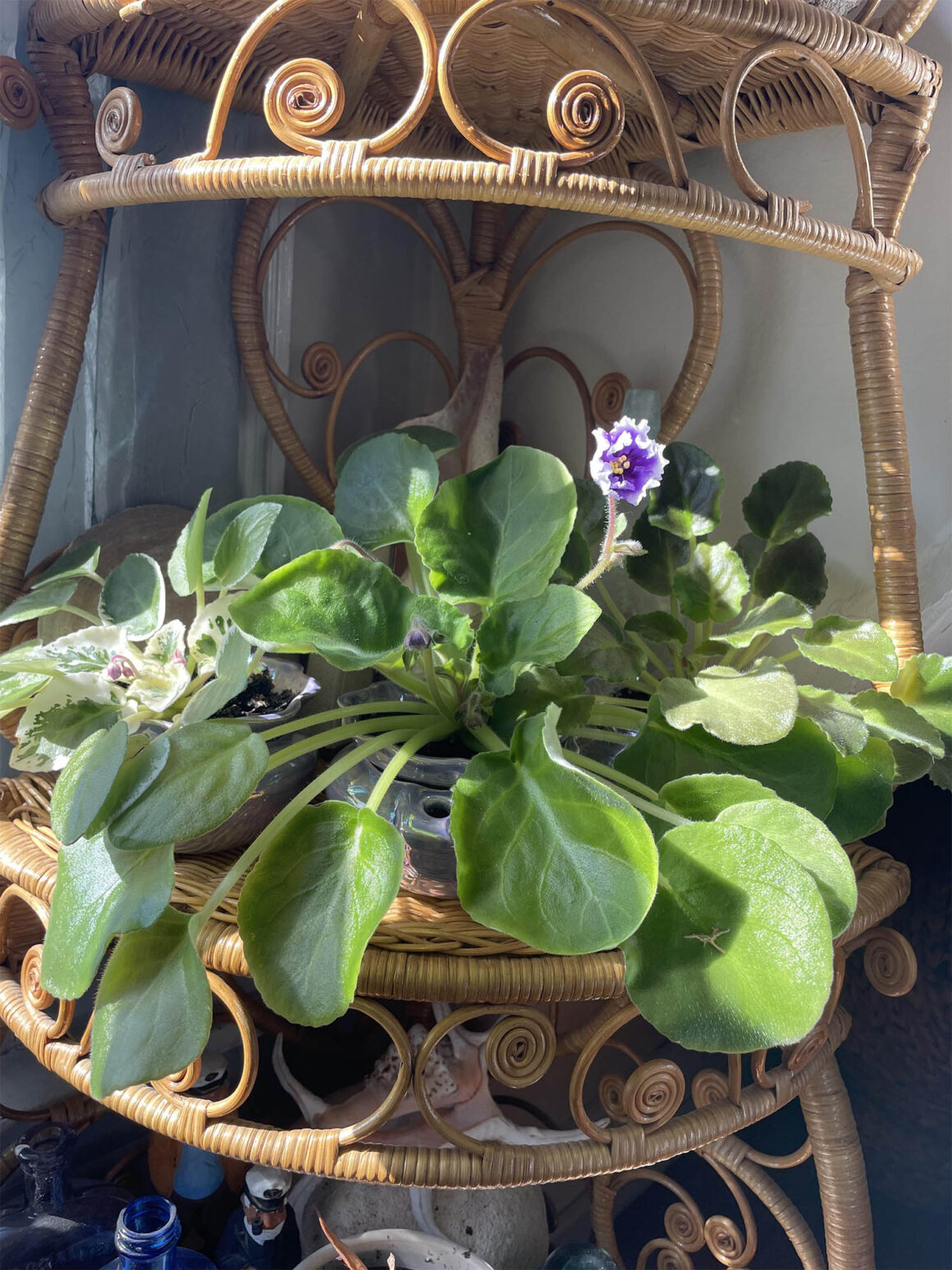
Etiolation makes the leaves and petioles thinner and more widely spaced. They also tend to grow up and out instead of in mostly-flat rows. And the foliage may fade to a fainter, lighter green. If your African Violet looks pale, stretched-out, and sparse, it’s probably not getting enough light.
Is Your African Violet Getting Too Much Light?
Overly bright spaces can also mess up your African Violet. Often, the problem is more with heat than light. Direct sunlight is much hotter than indirect light, and it can rapidly dehydrate your African Violet’s leaves. This can also happen with overly intense lights, though it’s less common.
Sun scorch causes your African Violet’s leaves to curl downward at the edges, turning crispy and brown. The discoloration often starts at the sides of the leaves, but not always. Sometimes it forms irregular blotches wherever the strongest sunlight has been shining. If your Saintpaulia has any blooms, harsh sun will make them fade and wither.
When you notice this happening, move your plant into a shadier spot right away. You can remove dead leaves, but we recommend leaving partially damaged ones in place. The healthy portions are still taking in sun to feed your plant. Removing too many leaves could cause a further shock to your African Violet’s system.
Mild cases of over-lighting may not cause obvious damage, but they’ll still alter your Saintpaulia’s appearance. Under too much light, African Violets tend to bunch up, with the leaves overlapping much more than normal. It’s especially severe in the middle of the plant, with the central leaves looking small and cramped. This is known as a “tight crown”.
Note that pale spots on the leaves might be caused by droplets of cold water rather than sunburn. And too much fertilizer can create a tight crown. You should still give your African Violet a bit more shade and see if it solves the problem, but be aware of those other possible issues.
How to Provide the Right Amount of Light for African Violets
Where can you place your African Violets to make sure they’re getting proper lighting? You’ll always have to adjust based on conditions in your home, but the following guidelines should help:
- Windows facing east and north are safe. East-facing windows only get direct sun in the morning, when the air is cooler. This makes for a good combination of bright light and low risk of sun scorch. Northern windows are even safer, but they’re also dimmer, so double-check to make sure they offer enough light.
- Southern and western windows require caution. If your African Violet is near a south-facing window, it will have plenty of light. But the risk of sun scorch will be much higher. Hang some curtains with a loose weave, or place the plant 4-6 feet away from the window. West-facing windows aren’t quite as harsh, but they come close.
- Pay attention to the height of grow lights. We recommend full-spectrum LED grow lamps if you’re growing your African Violet under artificial light. A small bulb like the Sansi 15W can sit 10-12 inches above your Saintpaulia. Larger lights should be farther away. If you have an illuminance meter, find a setup that gives your plant 900-1100 foot-candles of light.
- When in doubt, check the shadows. If you don’t have a fancy gadget for measuring light intensity, you get a rough idea using the “shadow test”. Bright, indirect light casts moderately dark shadows with defined shapes but hazy edges. Darker shadows with sharp outlines indicate direct light, which is too harsh. Vague, faint, blobby shadows usually mean the light levels are too low.
Adjusting African Violet Lighting
If your African Violet is getting too much light, move it somewhere dimmer right away. But if you’re trying to increase its exposure, do it little by little. Going from the shadows to bright light can cause shock.
Shift your African Violet into the sunnier area for a few hours a day. Then you can increase its time on the bright side by 30-60 minutes every day until it’s fully acclimated. Back off if you notice the leaves wilting or getting discolored.
Final Thoughts
Finding the right amount of light for African Violets can take some practice. However, if you keep our advice in mind, it shouldn’t take you long to get the perfect levels. With a bit of care and patience, you’ll find a location that gives your African Violet that healthy glow.






